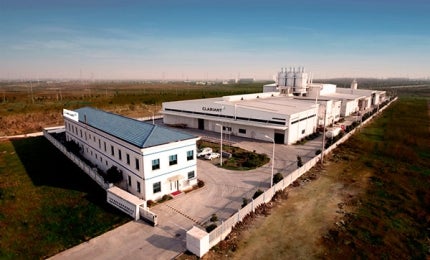
Swiss chemicals company Clariant opened a new desiccant manufacturing facility at its site in Zhenjiang, China, in April 2015. Aimed at extending the company’s footprint in Asia, the new facility manufactures full range of desiccant bags and Container DRI® II products and caters to meet the growing demand for desiccants in the region.
The new plant is Clariant’s second manufacturing plant in Asia, the first Container DRI II production plant was opened in Indonesia in March 2014. Besides these two sites, the company’s worldwide network includes plants in Brazil, Turkey and the US.
The new facility has a sustainable opportunity to provide high-quality desiccant bags in the Chinese market. The new site will also support the company’s expansion in the area of food protection in local and international markets.
Location of Clariant’s desiccant manufacturing plant in China
The new plant is located at Clariant’s existing site in Zhenjiang city in Jiangsu province, in eastern China. The site benefits from easy access to locally sourced bentonite clay. In addition, the company’s functional minerals business unit on the site offers drying facilities and supports the production of desiccant bags.
Production at the Clariant’s Chinese facility
The new manufacturing plant produces specially designed cargo desiccants and Container DRI II products for export packagers, machine manufacturers and food packaging. These products protect goods from moisture and water damage during shipping.
Desiccants such as silica gel readily absorb moisture and control the atmospheric conditions inside a container and maintain product stability. They are available in different configurations, including canisters, packets and closures for varying packaging needs.
In March 2014, Finnish-Swedish forestry and biomaterials company Stora Enso announced its plans to build a consumer board and pulp mill in China..
The Container DRI II product portfolio includes a wide range of container desiccants that provide versatile protection against humidity and moisture during transport. They play a vital role in preserving edible cargo and other sensitive goods during long transport across different climate zones.
Dew point control is one of the unique features offered by the desiccants. It helps to aggressively remove moisture from ambient air in order to prevent container rain and container sweat, which could potentially damage goods in transit.
The container desiccants are available in bags, poles and strips and absorb moisture up to three times their weight. They trap the moisture as a thick gel and hence prevent it from spilling.
Clariant’s sustainable practices
Clariant follows efficient optimisation processes to constantly improve energy-efficiency and water balance while reducing pollutant emissions. It encourages the use of renewable raw material sources and bio-based chemicals to create an increasingly sustainable value chain. By constantly improving process efficiencies and production procedures, it has gradually reduced waste materials, wastewater and emissions.
To reduce energy consumption, the company uses natural gas for a number of purposes, including heating dryers, firing crack furnaces and generating electricity in its own power plants. In some locations such as China and Indonesia, only coal is being used as an energy source.
Marketing commentary
Based in Muttenz, Switzerland, Clariant is a speciality chemicals company with presence worldwide. The company employs a total workforce of approximately 17,000 people and recorded sales of $6.26bn in 2014. It operates in four business areas, including care chemicals, natural resources, catalysis and energy, plastics and coatings.






